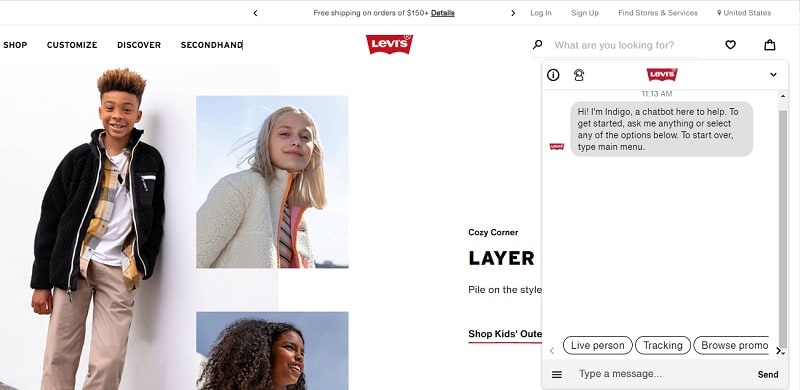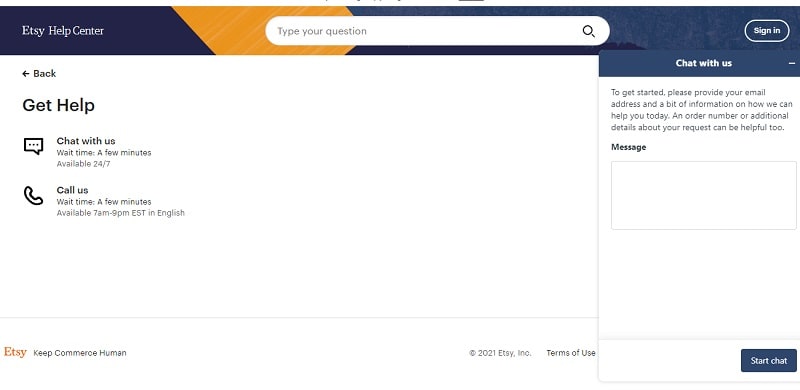Joseph Weizenbaum, a scientist and a professor at MIT, built the world’s first chatbot ELIZA back in 1966. Although chatbots have existed for more than half a century, businesses have only started using them over the past decade.
The growth of online retail and the need for automation is fueling the use of chatbots for eCommerce in 2022. A report by MarketsandMarkets Research Private estimates the global chatbot market to grow from $2.9 billion in 2020 to $10.5 billion by 2026.
So, if you’ve been wondering if now’s the right time to integrate a chatbot into your business operations: the short answer is — yes! And if you need more convincing, read on to learn ten ways how chatbots can boost your eCommerce businesses.
1. Increase leads
Market leaders like Amazon, Apple, and Google have raised the bar for customer satisfaction. As a result, customers now expect higher quality customer service from every business they interact with, no matter the size of the operation.
A survey by McKinsey & Company revealed that 75% of customers expect help within five minutes of contacting a business online. As leading providers offer innovative solutions, small businesses have two options. First, match customer expectations, or second, risk losing customers to prominent players.
Chatbots for eCommerce can help you ensure a near-instant response time for all customers. They can also serve as lead generation tools by engaging passive visitors as they browse your website. Chatbots can help you provide customers with helpful prompts as they make their way through your sales funnel.
Look at the chatbot on the Nivea website. It’s rather simple yet effective to help customers find their skin type by answering several questions. The chatbot directs website visitors to the page with the right products for their skin based on their answers. This allows the brand to increase conversions.

2. Boost sales
Chatbots act as an online substitute for a salesperson. They can respond to customer questions and help customers make informed decisions at crucial stages. Due to the recent advancements in AI and ML technologies, chatbots can do more than respond to generic queries with preset templates.
They can answer common questions, look up user reviews, and upsell and cross-sell products without human intervention. And that’s not all. They can also reduce cart abandonment by offering customers targeted discounts and friendly reminders to follow through with purchases.
Chatbots offer an easy way to build lasting customer relationships. Combined with a high-performance website designed by a Magento e?ommerce development company, they’re the perfect tool for boosting your online sales.
For example, *Staples, *an online office equipment retailer, uses a Facebook Messenger chatbot to allow its customers to buy directly from the chat. It helps site visitors to know whether specific equipment is in stock and makes personal suggestions based on their buying behavior.
3. Post-sale support
Post-sale support ensures a healthy customer retention rate. It also ensures you’re able to maintain the same level of service even during the post-purchase phase.
Post-purchase queries such as order status updates, payment issues, and refund requests are often the primary source of customer support requests for eCommerce businesses. With an automated tool like a chatbot, your business can reduce its operating costs significantly.
Chatbots can provide customers with real-time order status updates through integrations across your business systems. They can even offer live tracking updates from your logistic partners.
A European clothing retailer Zalando uses a chatbot to provide buyers with real-time information on order and shipping status right after making a purchase. This can help generate more leads and sales for the business.
4. Better personalization
Personalization allows you to create unique shopping experiences for your customers. Showing customers what they might like helps them find relevant products easily.
But the challenge is that you can only add so many product recommendation blocks on a page. And more often than not, customers start tuning them out as they’re shopping. So, how do you capture their attention and help them discover new products?
Ecommerce chatbots are the perfect tools for personalization. As customers navigate your website, a chatbot can offer them tailored product recommendations. Some chatbots can be localized to suit your target demographic’s local language. With AI, they can also navigate regionalisms and offer more contextualized shopping experiences. They can also provide targeted discounts to customers who may be ready to convert.
An example is a popular H&M store. It implements a KiK chatbot to ask customers questions about their style to offer them several most suitable outfits to choose from. This brings personalization to a completely new level.

5. Simplify customer service
Chatbots are revolutionizing customer service for eCommerce stores by solving customer queries even before reaching a human agent. And the best part is: they can do it at scale.
Chatbots can manage tens or hundreds of customer queries at the same time. They can provide answers proactively and ensure your customers get lightning-fast support. This will help your customer service agents stay free to tackle more complex tasks.
Some worry that chatbots will replace human agents. Although they reduce the workforce required to handle customer requests, they don’t eliminate the need for humans. Chatbots are ideal for large-scale eCommerce businesses looking for ways to eradicate repetition from their workflows.
Such as Lego, for example. The global toy store uses a chatbot named “Ralph” that simultaneously guides thousands of its customers through the catalog. It simplifies customer service by dividing users into age, region, and personal preferences.
6. Interactive knowledge base
The traditional approach to addressing frequent customer queries is implementing a knowledge base. Chatbots bring knowledge bases to life by allowing customers to explore them interactively. Moreover, they follow customers across your website. So, no matter where they are, help is always a click away.
And if the chatbot is unable to address their queries, it will redirect customers to a live chat agent. With fewer tasks on hand, your customer service agents will be able to step in immediately and address queries before customers abandon their purchases.
With easy access to information and assistance across your website, your customers will likely experience a frictionless buying experience that keeps them coming back for more.
For example, Levi’s uses a chatbot that helps customers find an ideal pair of jeans interactively. It also provides recommendations synced up with real-time inventory to avoid cart abandonment due to out-of-stock products.

7. Deeper insights
Top eCommerce chatbots on the market, such as Chatfuel, LiveChat, and Pandorabots, implement AI technology that tracks real-time customer interactions on your website. They allow you to watch customers as they make their way through your store and even let you initiate conversations manually.
You can use the data gathered by chatbots to analyze customer behavior and gain insights into what makes them click. You can combine chatbot analytics data with data from other tools such as Google Analytics and even your store performance reports to visualize the entire customer journey.
Such granular insights can help you improve your product offerings, store design, and maximize service efficiency across your business operations. Moreover, it can help you optimize your business processes to reduce costs while increasing conversions and sales.
The eBay chatbot is a perfect example of that. This AI-based chatbot allows customers to find their perfect item among billion of others and gathers customer insights. This is what eBay’s senior director of company communications says about it: “Going out early with our eBay ShopBot gives us the ability to gain insights and to continue to evolve our bot while creating new and personalized experiences, based on how consumers are shopping.”
8. Easier feedback collection
Customer feedback is a great way to understand customer needs. However, gathering feedback is a challenge for nearly every eCommerce business, no matter its size.
Most businesses usually take one of two approaches to gather feedback. They either use web forms or rely on product reviews for insights into customer preferences.
Unfortunately, both methods are rather time-consuming and experience low success rates. That’s because only 1 out of 26 unhappy customers ever complain, according to research conducted by Esteban Kolsky, CEO of thinkJar.
AI-based chatbots can be programmed to trigger feedback requests in real-time when they detect exit intent. So, they can gather feedback at the exact time a customer decides to abandon a purchase and help you understand customer pain points.
The above-mentioned eBay chatbot allows customers to provide feedback on items and sellers after making a purchase.
9. Multichannel reach
In the digital age, customers can reach businesses in many ways. Traditional methods include contact forms and emails. Modern approaches such as social media are popular today.
But managing many channels and ensuring consistent service across them is a challenge. How can you guarantee the quality of customer service provided via email is the same as that on Twitter or Instagram?
You can solve this problem by using chatbots. They can provide your customers with timely assistance across all digital touchpoints no matter where they are. What is more, they can direct customers across channels.
Domino’s AnyWare is a chatbot that allows pizza lovers to make orders from multiple channels including Alexa, Google Home, Slack, Facebook Messenger, and Tweeter.

Despite its multichannel reach, the bot is rather simple to chat with.

10. Round the clock support
According to a report by Ubisend, over 50% of consumers surveyed say that they expect businesses to be available 24 hours a day, on all seven days of the week. But providing 24/7 support with human agents can be challenging and expensive.
Chatbots are a great alternative to 24/7 human customer service agents. They can operate all year round across multiple touchpoints at no extra cost. If they don’t know the answer to a customer query, they can gather information and generate customer service tickets through integrations with your CRM.
In doing so, chatbots ensure no customer query goes unanswered. This maximizes the likelihood of converting every lead generated through your online channels. More importantly, it gives your customers the best shopping experience possible.
For example, the Etsy chatbot offers personalized 24/7 customer support to help customers any time of the day. This allows an American retailer of handmade things to resolve any issues quickly and, this way, to increase the number of returning customers.

Related Content
- The Case for Chatbots in Marketing
- Chatbot Strategy: 6 Ways to Transform Your Online Marketing With Bots
- How Expensify Got 5X More Customers with Chatbots
- How to Use Artificial Intelligence in Digital Marketing
- 5 Radical Ways AI Is Making Waves On Social Media
eCommerce chatbots: A competitive edge for your online business
Chatbots for eCommerce is a new approach to improving customer experience, generating leads, and driving sales. They offer many advantages over the traditional modes of engagement and can help you resolve customer queries 24 hours a day.
AI-based chatbots provide your customers with more ways to interact with your business and help you gather deep insights into customer preferences. If you haven’t considered a chatbot for your eCommerce business, it’s time to start now.

Written by our guest writer Val Kelmuts, the Chief Executive Officer and Co-founder at Staylime
an ecommerce design and development company headquartered in Redwood City, California. Val has 10 years of experience in custom software development, sales management, and business development. He is the Adobe Commerce sales accredited specialist, Shopify business certified expert, and PMI member.



